#pre-hispanic
Text
1,200-year-old lord's tomb laden with gold unearthed in Panama

Archaeologists in Panama have discovered a 1,200-year-old tomb belonging to pre-Hispanic royalty that also contains a sizable gold collection.
The tomb is located in El Caño, an archaeological park in the Coclé province of central Panama. It is the final resting place of an "important Coclé lord," according to a translated statement from Panama's Ministry of Culture.
The lord likely lived during the late 700s and would have been in his 30s when he died, according to an El Caño Foundation Facebook post.
The tomb contained an impressive amount of grave goods belonging to the unnamed royal, such as ceramic artifacts and gold pieces from a funerary trousseau — a collection of an individual's personal possessions. Read more.
408 notes
·
View notes
Photo
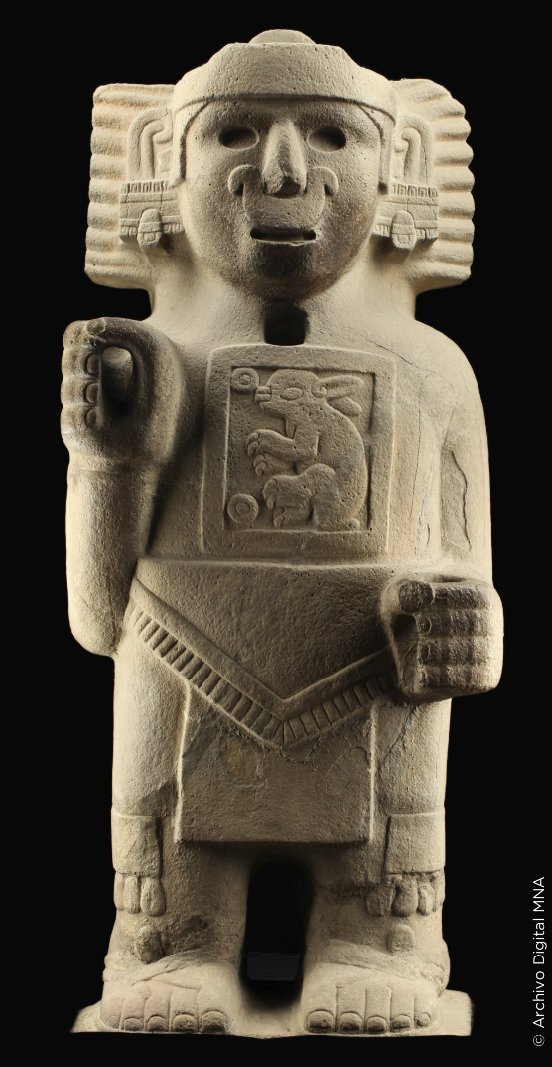
“ Este portaestandartes huasteco retrata a una deidad del pulque, puesto que la fecha dos-conejo era el día en que se le festejaba junto a esta bebida. La rigidez de la composición denota influencia mexica, pues la escultura huasteca era mucho menos rígida en periodos anteriores”.
A Huastec pulque deity with a rabbit design on its chest. The 2 rabbit day was the day in which the drink was celebrated. It’s believed to have Mexica influence in its design due to Huastec sculptures were less rigid in prior times.
291 notes
·
View notes
Text
Wow - You really don’t want to miss this monumental discovery!
Urban developments under the Amazon rainforest in Ecuador - the like of which have never been seen before - have been revealed by LiDAR mapping. The vast urbanization includes city streets lined with houses, public squares and platforms and an extensive, deeply dug road network connecting various settlements, that are 1000 years older than any previous such finds in Amazonia!
“This is older than any other site we know in the Amazon.” Prof Stephen Rostain.
The development includes comprehensive agricultural systems with drainage and terrace setups, alongside lengthy, straight roads spanning considerable distances. The study records 6000 platforms.
This significant early urbanization in the Upper Amazon matches the complexity seen in the Maya urban layouts recently discovered in Mexico and Guatemala. The find seriously challenges the Eurocentric beliefs around civilization development, with this being contemporaneous with the Roman Empire.
This monumental discovery is set to revolutionize beliefs about ancient life and society in the Amazon region!
36 notes
·
View notes
Text

Quadrangle of the Nuns | East Building, Uxmal, Mexico, 906 AD
VS
Emporio Armani, Logo, 1981
#uxmal#maya#archaeology#ruin#ruins#america#yucatan#unesco#world heritage#world heritage site#Pre-Hispanic#maya civilization#armani#giorgio armani#logo#fashion#clothing#eagle
53 notes
·
View notes
Text
Is the Philippines patriarchal during the pre-Hispanic period or not?
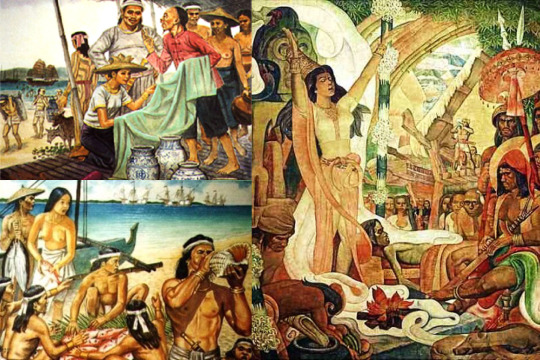
Journey #2
I spent hours of finding proof if my country which is the Philippines patriarchal during the pre-Hispanic Era or not. At first, I would say yes. Because based on my understanding, the leaders during those times were all men such as the Datu. But upon reading on our modules some articles online, I realized that the community structure of pre-Hispanic Philippine society could neither be described as a patriarchy nor a matriarchy.
Prior to the arrival of the Spaniards, the Philippines was composed of villages called “barangays” and each barangay was ruled by a Datu, Rajah, and Sultan or Hadji. He governed his territories, led his soldiers to war, commanded his armadas at seas, protected his villages from enemies, and settled disputes among his people. One could be a datu chiefly by inheritance, wisdom, wealth, or physical prowess. Known leaders during those times includes Lapu Lapu, Rajah Humabon, and, Rajah Sulayman. Clearly, the datu was perceived to be very powerful. However, this power was equally matched by the babaylan.
Before the Spanish colonized the Philippines, there existed a 500-year long tradition of indigenous feminism that was called Babaylan. They referred to female mystical healers whose spiritual connectedness was a source of political and social power. Babaylan women act as an intermediary between the spiritual and material worlds between the community. Their leadership roles includes warrior, healer, priestess, sage, and advisers of the Datu.
In conclusion, the Philippines during the pre-Hispanic period is neither be described as a patriarchy nor a matriarchy since during those times, women were regarded as equals to men. The Babaylan was one such evidence of the powerful and central role that women played in society at that time. That social order came to an end when the Spaniards arrived.
References:
Pre-Colonial Philippines’ Longstanding Tradition Of Women Leadership And Mysticism. (2016, March 3). Retrieved from
Limos, M. (2019, March 18). The Fall of the Babaylan. Retrieved from
Abinales, Patricio and Amoroso, Donna. (2005). State and Society in the Philippines. Lanham, Maryland: Rowman & Littlefield Publishers, Inc.
Scott, William Henry. (1994). Barangay: Sixteenth-Century Philippine Culture and Society. Manila: Ateneo de Manila University Press
4 notes
·
View notes
Text
Juan O'Gorman: Architect and muralist extraordinaire, his Central Library is Mexico's Eiffel Tower, blending pre-Hispanic and European influences. Beyond aesthetics, his schools championed hygiene, anticipating modern needs.
0 notes
Text
Discovery: Asceta
Asceta is technically an act we haven’t covered before on the blog but the man behind it is well-known to us. Bernardo Alvarado Rojas is the guitarist and producer for Kalmo, a neoclassical collective who we featured a few times in 2020. Asceta is his new project, celebrating the pre-Hispanic music of his homeland, Mexico.
(more…)

View On WordPress
#ambient#Asceta#atmospheric#Bernardo Alvarado Rojas#electronic#groovy#indigenous#Kalmo#Mexico#neoclassical#Peregrinaje al Cosmos#piano#pre-Hispanic#unique
1 note
·
View note
Text
So you’ve heard of “Lance talks about Keith and Spanish and Keith has no idea what’s going on” a beloved classic
But I bring you “Keith’s a born and raised Texan, (Texas has one of the highest Spanish speaking populations in the US) who was also partially raised by Adam who spoke Spanish around the house a lot. And so he understands most of what Lance is saying but is to embarrassed to admit he knows that Lance has talked about how soft his hair looked on at least three separate occasions “
#vld#keith kogane#voltron#voltron legendary defender#keith voltron#keith headcanon#character headcanons#hcs#broganes#autistic keith#pre kerberos#keith is a menace#lance mcclain#adam voltron#adashi#Hispanic Adam voltron#cuban lance#keith vaguely knows what’s going on#klance#texan keith#pining Lance
1K notes
·
View notes
Text
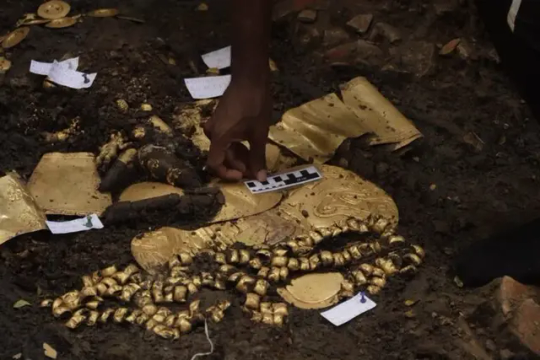
A Major Tomb With Gold and Ceramic Artifacts Discovered in Panama
In an archaeological find in the El Caño Archaeological Park, located in the district of Natá, province of Coclé, in Panama, a tomb has been discovered that sheds light on the sophisticated Coclé society of pre-Hispanic times.
The tomb thought to belong to a Coclé lord and dating back to 750 CE, was found to contain a wealth of funerary offerings, including ceramic and gold artifacts.
The El Caño Archaeological Park is well-known for its necropolis of tombs and stone monoliths that date back to 700–1000 CE. American explorer Hyatt Verrill first realized the importance of the site in 1925 when he discovered ancient monoliths beside the Rio Grande River.
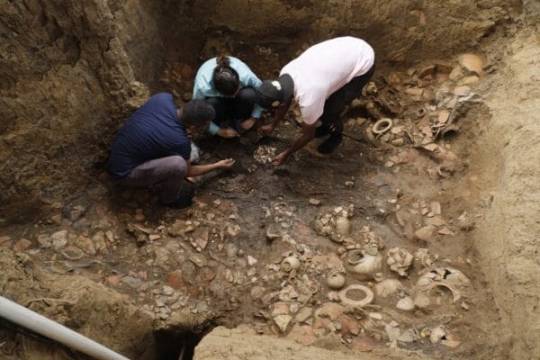
Linette Montenegro, National Heritage Director of the Ministry of Culture (MiCultura), explained that this discovery is part of the ongoing archeological project in the park.
The project, started in 2022 and financed through a cooperation agreement between the Ministry of Culture and the El Caño Foundation, aims to thoroughly explore Tomb No. 9 during the 2021-2024 campaigns.
The tomb’s contents, consisting of 5 pectorals, 2 belts of gold beads, 4 bracelets, 2 earrings in the shape of human figures, an earring in the shape of a double crocodile, 1 necklace of circular beads, two bells, bracelets, and a skirt made with dog teeth, and a set of bone flutes, is testimony to the cultural and social wealth of the Coclé society.
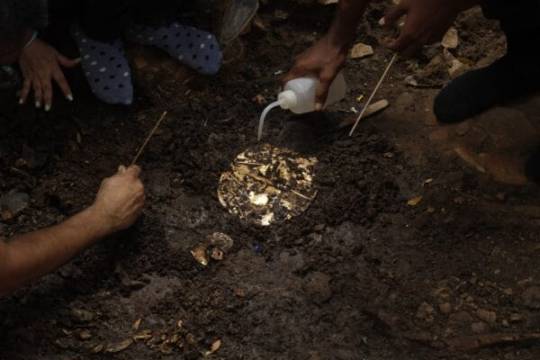
Dr. Julia Mayo, director of the El Caño Foundation and leader of the archaeological project since its inception in 2008, highlighted the importance of this discovery.
The collection, which probably belonged to a high-status adult male, represents a window into life and death in the Rio Grande chiefdom. The tomb, built around 750 A.D., is especially intriguing due to the presence of sacrificial attendants buried alongside the lord, indicating multiple and simultaneous burial practices.
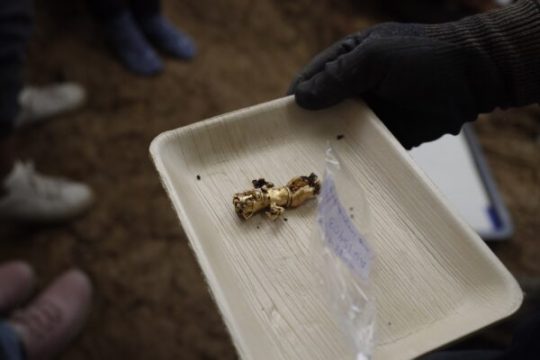
Dr. Mayo noted that the excavation process is ongoing, making it difficult to determine the exact number of individuals buried within the tomb. She said that this type of burial, known for burying a variable number of people in the same tomb, provides valuable information about the beliefs and funerary rituals of the Cocle society.
Dr. Mayo explained that the Coclé lord was buried in a face-down position, a customary practice in this culture, often atop the remains of a woman.
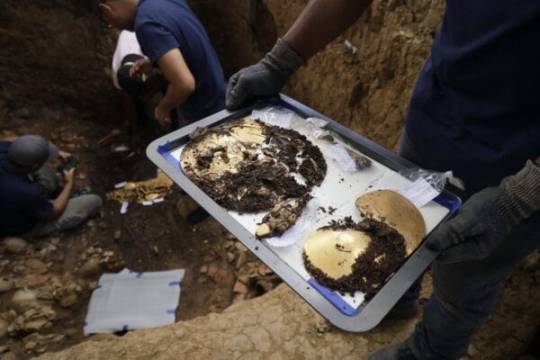
El Caño Archaeological Park, built around 700 A.D. and abandoned around 1000 A.D., has yielded significant archaeological discoveries. In addition to the known monoliths, the site includes a cemetery and a ceremonial area with wooden structures. This discovery stands out for its uniqueness and the insight it provides into Cocle society’s funerary practices.
By Oguz Buyukyildirim.
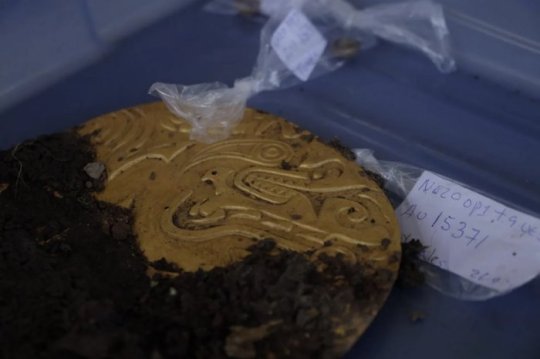
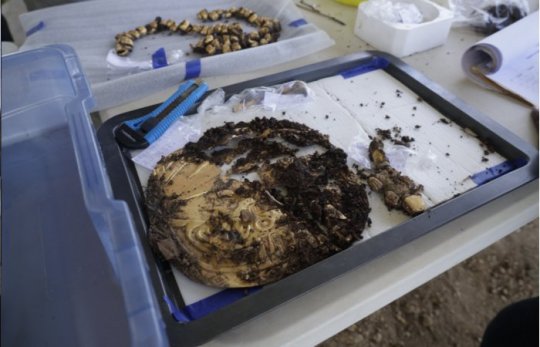
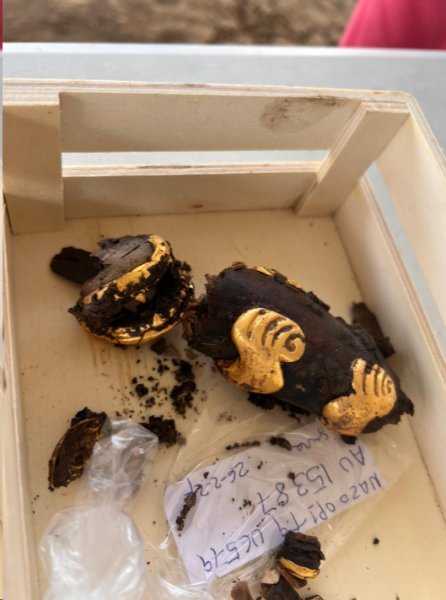
#A Major Tomb With Gold and Ceramic Artifacts Discovered in Panama#El Caño Archaeological Park#Coclé lord#ancient tomb#ancient grave#ancient necropolis#ancient artifacts#gold#gold artifacts#treasure#archaeology#archeolgst#history#history news#ancient history#ancient culture#ancient civilizations#Coclé society#pre-Hispanic times
93 notes
·
View notes
Text
Peru police find pre-Hispanic mummy in ex-delivery man's bag

Police in Peru have seized a mummified human, between 600 and 800 years old, from a former food delivery man who claimed to have had it at his home for three decades.
The mummy was in the isothermal bag the man had once used to deliver food to people's homes.
The man, 26-year-old Julio Cesar Bermejo, will remain in detention while investigators look into the case, a government official told AFP on Tuesday.
Bermejo told local media the mummy, who he called "Juanita," was "like my spiritual girlfriend."
"At home, she's in my room, she sleeps with me. I take care of her," he said in a video that went viral on social media. Read more.
2K notes
·
View notes
Text

The feather headdress worn by actor Tenoch Huerta at the Black Panther: Wakanda Forever comic-con presentation, is called a copilli.
The Copilli (plural: copiltin) can be translated as 'feather headdress' or 'feather crown' and it's made from 'precious' feathers that in the pre-Hispanic world represented the union between the earthly (us) and the divine (gods).
Made by mexican artisans: Hijos del Maiz
"The chosen colors were black and blue as a reminder of the personality of his character Namor, who lives in the depths of the ocean in a hidden underwater city and that apparently will have a strong link with the Mayan culture, belonging to the southern Mexico and part of Central America."

#namor#tenoch huerta#arte plumario#feather headdress#marvel#mexico#artisans#pre hispanic#fashion#mcu#sdcc#copilli#feather art#black panther 2#wakanda forever
1K notes
·
View notes
Text
Archaeologists have uncovered the incredible gold-filled tomb of a Coclé lord, filled with pre-Hispanic historical treasures, in Panama's El Caño Archaeological Park.
21 notes
·
View notes
Text
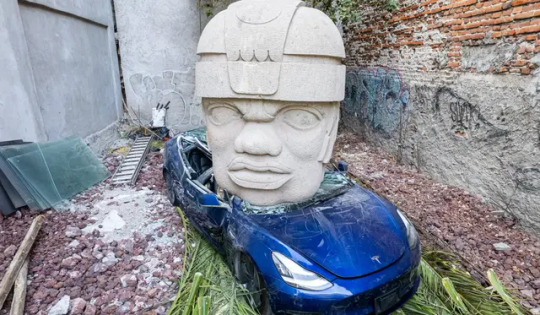

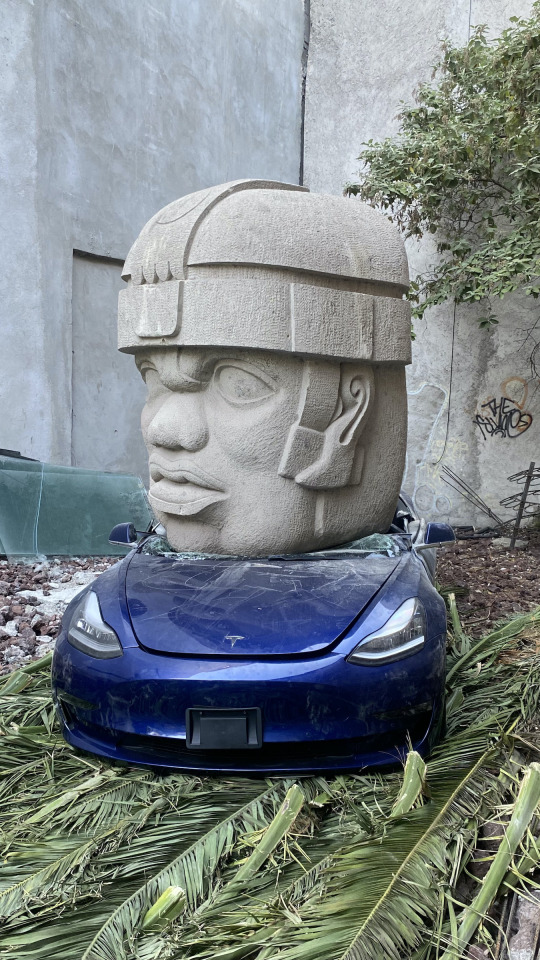
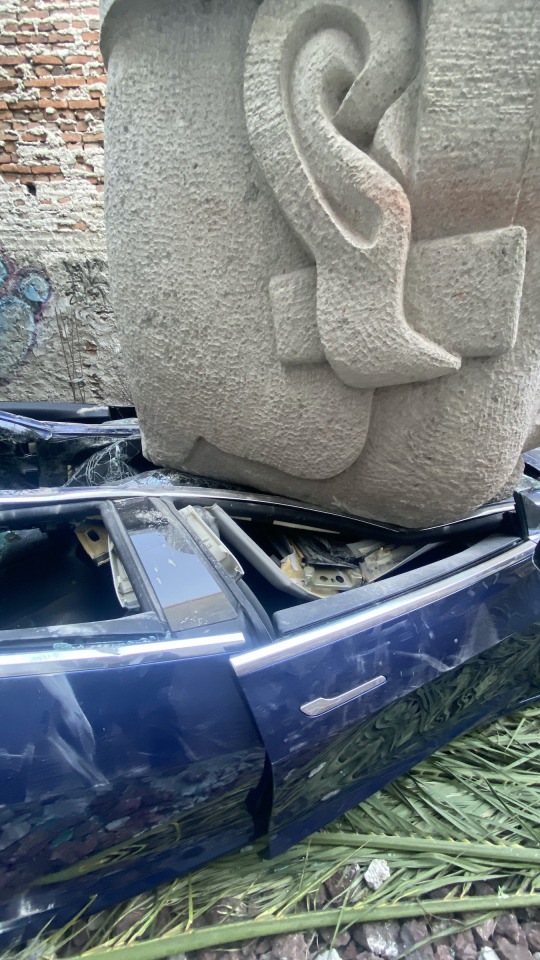
Chavis Mármol's Neo-Tamene (from the series)
Sculptor Chavis Mármol has never owned a car, but that’s never inhibited his drive. Earlier this month, the 42-year-old Mexico City-based artist (who travels largely by bicycle) dropped a nine-ton replica of an Olmec head onto the roof of a blue Tesla Model 3.
The car was donated by Colima 71,, a boutique hotel in Mexico City.
The work is a mix of humor and criticism that explores the Mexican pre-Hispanic past from a Western neo-colonial perspective.
All photos by and courtesy the artist
#art#surreal#fun#funnyshit#funny shit#funny pictures#sculpture#chavis marmol#neo-tamene#mexican#neo colonialism#pre hispanic#human rights#head#tesla model 3#tesla#elon musk#olmec#colima 71#mollusk#consumerism
67 notes
·
View notes
Photo

Ricardo Martínez
Pareja. 1992
#ricardo martínez#ricardo martínez de hoyos#figurative art#chiaroscuro#mexican school of painting#avant-garde#pre-hispanic view#contemporary art#mexican artist#fundacion ricardo martinez#artistic nude
62 notes
·
View notes
Text
Tlatelolco's Aztec market was a vibrant explosion of trade, boasting exotic goods from across Mesoamerica and everyday essentials. A pre-Hispanic Amazon where jade shimmered, chocolate melted hearts, and life pulsed with every haggle and barter.
0 notes